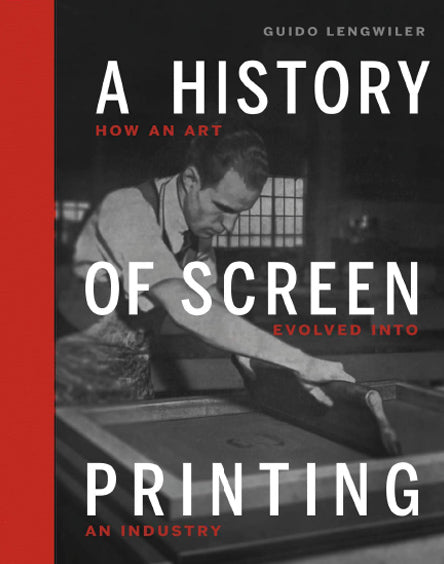
Screen Printing: Type of Printmaking

|
PRINTMAKING TERMS POSTERS |
Screen Printing: Type of Printmaking
One of the newest types of art in the West, screen printing (screenprinting, silkscreen, or serigraphy - from sericum, Latin for silk) is a twentieth century intaglio printmaking technique derived from traditional stencilling, itself one of the earliest forms of graphic art duplication. Usually, screen printing involves placing a fine mesh screen, which is stretched tightly over a wooden frame, above a piece of paper. Then colour is forced through the screen with a rubber blade called a squeegee. Usually the screen is made of silk, hence the name silk screen printing. However, as cotton, nylon or metal can also be used, the more inclusive term is screen printing. Some professional artists prefer to use the term serigraphy to differentiate between artistic screen printing and that of commercial printing. Screen printing was first developed about 1900 and used in advertising. Eventually it was popularised by American Pop artists like Roy Lichtenstein, Robert Rauschenberg, and Andy Warhol, as well as other contemporary art movements. These artists chose the medium of screen printing because it allowed them to maintain bold, bright colours when reproducing their works. Boldly colourful and novel, screen printing has become one of the basic techniques of postmodernist art.
|
|
|
History of Screen Printing A style of screen printing first appeared in China during the era of Song Dynasty Art (960-1279), and made its way to Europe in the 18th century. However, it was not until silk mesh was more available for trade in the 19th century that screen printing began to pick up popularity. In 1907 Samuel Simon patented screen-printing in England. At first, the process was used to print interesting colours and patterns on wall paper and fabrics and then by advertisers. Eventually however it was adopted by artists as a convenient and reliable way of reproducing their works. In todays contemporary world screen printing is used by fine artists, and along with commercial printers who use graphic screen printing to place images on t-shirts, DVDs, glass, paper, metal and wood. In the 1930s a group of artists, who wanted to differentiate what they did from the commercial world, formed the National Serigraphic Society. In doing so, they linked the word Serigraphy with fine arts and screen printing. 'Seri' is Latin for silk and 'graphein' is Greek for to write or draw. In recent history, the Pop Artists are generally seen to have popularised the form of screen printing known as serigraphy. Pop artists, took their images from the world of mass culture, so it was appropriate that they used a technique known for its mass production ability. Op artists also valued the use of the medium, finding it suited their aesthetics. |
|
|
The Basic Screen Printing Process In screen printing, the screen is first created by stretching a fabric (eg silk) over a frame of wood or aluminium. The image is first drawn (manually or with software) on a piece of paper or plastic, or captured in a photograph. Then it is cut out to form a stencil. Next, the stencil is attached to the screen. Then areas of the screen mesh are blocked with a waterproof masking medium. These areas become the negative areas of the final image. The screen is then placed over the desired substrate (eg. paper, glass, textile) and ink is then applied to top of the screen and spread across the screen, over the stencil and through the open mesh onto the substrate underneath. The ink is spread using a squeegee - a rubber blade usually the same width as the screen. The unblocked area is where the ink filters through and creates the image. Any number of colours can be used, although a separate screen is required for each colour. The stencil designs are generally created using software programs like Adobe Illustrator or Corel Draw. The designs are then printed on clear vellum, which is referred to as the film positive. Film Images Used in Silkscreen Printing Using modern technology with UV sensitive photo emulsions, images can be created on transparent film and then replicated exactly on a nylon screen coated with light sensitive (UV) emulsion. The latter is applied to the whole screen which is then overlaid with the film upon which the artist has drawn his design, and both are exposed to UV light. The light passes through the transparent film, except where the artist's design prevents it. On those parts of the screen exposed to the light, the emulsion hardens. When the screen is then washed, all the emulsion is removed except for the hardened areas, thus creating a stencil on the screen that exactly matches the design down to the smallest detail. Famous Silkscreen Artists Famous screen printers include Andy Warhol (1928-87) with his silk screen prints: Campbell's Soup Can on Shopping Bag (1966), Triple Elvis (1962), andMarilyn Monroe (1967), among others; Robert Rauschenberg (b.1925) with his Retroactive II (1964); Ben Shahn (1898-1969) with his silkscreen printPleiades (1960). The Pop Art leader Andy Warhol had a background in commercial art, which gave him a particular affinity with the technique of screen printing. Both Warhol and Rauschenberg extended the technique by screen printing a design onto a canvas to serve as the basis of a painting. Other figures of contemporary art, like Eduardo Paolozzi, Richard Hamilton and R B Kitaj used the medium to combine second-hand images as a kind of collage technique. Complexity of technique has increased, the American Superrealist painter Richard Estes sometimes uses up to 80 screens in one work. World's Most Valuable Silkscreen Print According to fine art writer Sarah Thornton in a November 2009 edition of the Economist, an anonymous purchaser bought Andy Warhol's silkscreen print Eight Elvises for $100 million (£60.5m) in a private sale.
|



